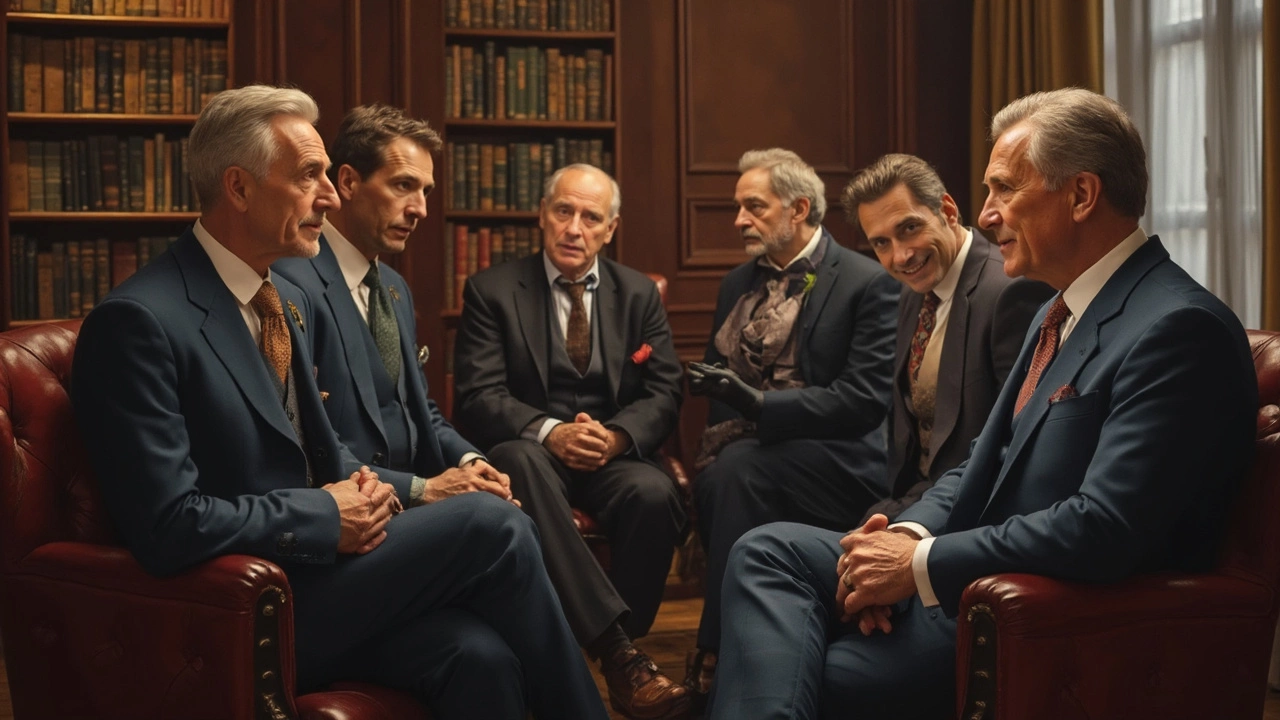There’s something quietly powerful about walking into a room and commanding respect, not with bravado, but with the way you carry yourself. It’s a mix of intention and subtlety—a rare blend in the world of hurried handshakes and louder voices. The old stereotype of a gentleman as an upper-crust relic has faded; today, the code is subtler but still fiercely relevant. What’s actually expected of someone who considers himself a modern gentleman? When I asked my son Jasper what makes a true gentleman, he skipped the usual answers about suits and watched faces instead. “Someone you trust to do the right thing, even when nobody’s watching,” he said. In that single sentence, I realized we’ve outgrown the clichés; the code, while centuries-old, pulses with new life.
The Foundation: What Is the Gentleman’s Code?
The gentleman’s code isn’t etched on stone tablets, yet its spirit persists across centuries and continents. Etymologically, 'gentleman' once denoted social class. Now, it’s a matter of character and conduct. The code values respect, quiet confidence, and discipline rather than showmanship or unwavering obedience to rigid old rules. To many men in London and beyond, these values show up in small daily choices: giving up a seat on the Tube, letting a heated moment pass without drama, or simply keeping promises. It’s not about perfection, but about consistent improvement and measured response to the world’s noise.
A study published by The King’s Fund (2023) highlighted how social behaviour based on empathy, decorum, and personal accountability tends to result in stronger professional and personal relationships. Data aside, these values build trust and foster environments where people actually want to engage. The code is less about strict etiquette and more about intention. Good manners? Absolutely, but without the performative airs. Style? Certainly, but not if it overshadows authenticity. There’s substance under the polish—a pragmatic balance of appearance and reality.
Let’s break this down even further with a simple table. These are not just arbitrary traditions, but guiding principles followed by modern men in respected circles:
| Principle | Modern Expression |
|---|---|
| Respect | Listening intently, regardless of status |
| Courtesy | Digital etiquette as much as in person |
| Accountability | Owning mistakes, not shifting blame |
| Composure | Responding, not reacting, under pressure |
| Consistency | Keeping your word, big or small promises |
So, the code is really a set of lived values. A modern gentleman may never mention them, but those who know, know.
Tangible Actions: How the Code Plays Out Daily
The everyday habits of a gentleman rarely call attention to themselves. It’s the man who uses silence as expertly as speech, who treats every interaction as if it matters—even when there’s nothing at stake. This isn’t about affectation, but about being present and aware. Living in central London, I see countless examples during the blur of daily routines. Whether it’s taking the time to thank the barista by name, or waiting patiently at a crowded train platform, the code turns routine moments into quiet opportunities for respect.
The power of eye contact, for instance, is hard to overstate. Psychologists at University College London demonstrated that eye contact can increase trustworthiness ratings by up to 23% during first meetings. The difference between a placid gaze and genuine engagement is often what separates authentic manners from hollow gestures. The gentleman’s code is also about confidentiality—keeping private matters private, in an age that’s addicted to oversharing. I’ve found that discretion—both online and offline—earns trust, sometimes more than grand displays ever could.
Here are straightforward habits that anchor the code into daily life:
- Prioritise punctuality. Being late tells others that their time is worth less than yours.
- Dress for the occasion, not for validation. Let your clothes reflect respect, but never seek approval through a label alone.
- Be direct but kind in communication. Good conversation sits at the core of trust.
- Show up. Whether at work or with family, physical and mental presence matters far more than grand gestures.
- Know when to apologise—and do it without qualifiers.
- Don’t assume. Ask. Questions prevent misunderstandings and demonstrate humility.
This sort of discipline need not feel tiring or forced. Model these small actions and others pay attention—your children most of all. I’ve watched Jasper mirror how I greet neighbours or hold the door for someone in need, proof that daily actions ring out far louder than any self-proclamation.

Style and Presentation: More than Just Surface
The modern gentleman doesn’t seek the limelight, but he doesn’t shrink from it, either. His presence is felt not by the cut of his suit alone, but by his quiet command of self. Style, as I see it, is never accidental, yet it avoids the trap of ostentatious display. Suits tailored to fit—not to flaunt; accessories minimal and meaningful. The current crop of London’s best-dressed men prove that understatement is the new extravagance.
It’s very tempting to equate style with steep price tags or a wardrobe full of designer logos. Yet, according to a 2024 retail study by British Menswear Association, 67% of UK professionals admitted that they judge colleagues less by what they wear than by grooming and posture. Well-cared-for shoes, pressed collars, and clear skin do more heavy lifting in first impressions than the flashiest belongings. Dressing well is simply another form of respect—for yourself and for those you’ll meet.
Here’s where it gets interesting: the modern code allows for adaptation. If your job is creative or your industry more relaxed, the code flexes to fit context. A tailored blazer and clean trainers in Shoreditch signal the same intent as a full suit in Mayfair. Grooming follows suit—neat nails, trimmed beard, and a scent that invites, not overpowers. Think muted tones, breathable fabrics, sharp lines. The intention is never to distract from your words but to strengthen them.
Consider the classic image of a modern workspace. Picture a man at his desk: watch with leather strap, cufflinks (subtle, not screaming), a tidy laptop bag. The message? He is in command of both details and vision. In a world of constant shift and clatter, these small choices add up, letting you navigate boardrooms, cafés, or dinner tables with understated poise.
For photographic inspiration, imagine a sequence: straight-backed man in bespoke navy, misty London rooftops behind him; next, a soft-focus close-up on hands tying muted patterned tie; finally, the calm of a meticulously organised workspace—neutral palette, natural light, polished wood, single fountain pen. Each reminds us: style is both language and intent.
Mindset and Values: Building from Within
The true foundation of the gentleman’s code lies in the mind—an arena where conviction and reflection replace bravado. There is a composure that comes from knowing you needn’t always have the last word. It is a certainty that has room for humility. If there’s a north star here, it’s the commitment to ongoing development. The code provides scaffolding for resilience during challenge and celebration alike.
Mental health, once taboo in these conversations, now sits centre stage. A 2022 NHS Digital report revealed that men who regularly talk about emotions with peers or mentors are 31% less likely to report high levels of stress. Openness isn’t a weakness; it’s modern strength. The code asks for honest appraisal—where are you strong, where do you need help, where might you quietly improve? Curiosity, far from being childlike, unlocks new perspectives and fuels growth.
Part of the code is firmly rooted in service. This isn’t self-sacrifice in the Victorian sense, but a quiet understanding that your words and actions ripple out to others. Mentoring younger colleagues, volunteering in your community, or even checking on a friend after a tough week—these are the unsung moments that few will ever see, yet they define you more than titles or possessions.
One of my favorite reminders comes from Tom Ford, who told Esquire in 2019:
"Dressing well is a form of good manners."Politeness can look like style, yes, but it also lives in remembering names, listening fully, and accepting no reward for basic dignity.
The modern code stands apart from performative virtue. It values questions over pronouncements; calm over drama. Build your routines on this bedrock—a morning walk, reading to learn, a handwritten note now and again—and you’ll find those around you respond in kind.

When the World Shifts: Adapting the Code for Modern Times
As the world grows noisier and faster, many traditional values are either romanticised or tossed aside as dated relics. The truth is, the code remains not because it resists change, but because it evolves. In 2025, the expectation for men is broader: to lead, yes, but also to admit faults and seek new understanding. The digital age brings new etiquette—think about how quickly WhatsApp etiquette descends into chaos with one misjudged emoji or a poorly timed message. The modern gentleman applies the same rules online as he does in person: composure, clarity, and respect for boundaries.
Career dynamics demand flexibility. Remote work calls for thoughtful communication, clarity in intentions, and respect for others’ time zones and boundaries. During the surge of hybrid work in London’s legal and finance sectors, the best-regarded professionals were not always those who worked latest, but those who respected others’ balance and delivered consistency.
Let’s not sidestep relationships. Romance, friendship, even parenting–every sphere is richer for the quiet discipline the code offers. With Jasper, I emphasise follow-through. Promises kept (or honestly renegotiated) matter more than elaborate gifts. In partnerships, listening becomes the cornerstone, while haste or complacency erodes trust. A gentleman’s word, whether in a boardroom handshake or at his son’s bedside, remains his bond.
If you’re aiming to live the code, you’ll find there is no secret handshake, no finishing line, no medal for daily discipline. It’s a lifelong process—sometimes invigorating, sometimes quietly demanding, always deeply rewarding. The modern gentleman does not announce himself; his impact speaks in the ways he shows up, adapts, and offers presence without need for applause. That is the code.

